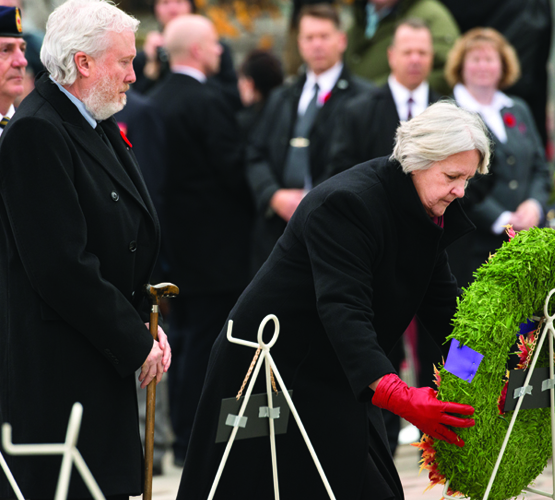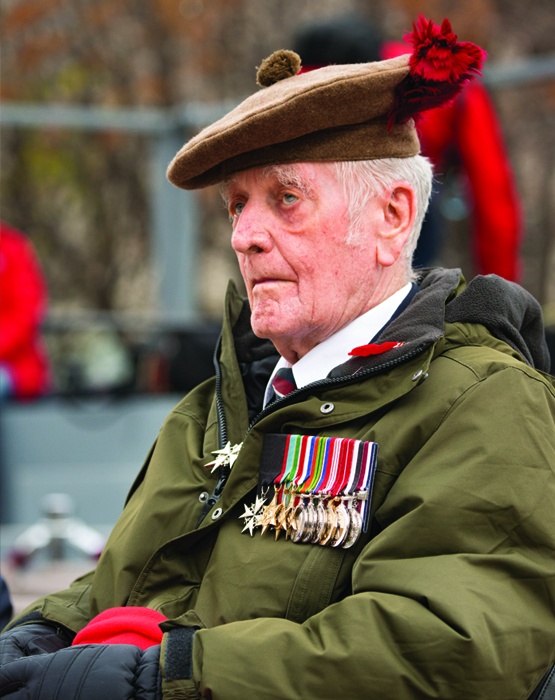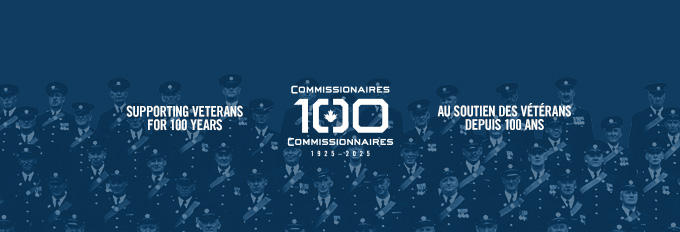
Poppies are placed on the Tomb of the Unknown Soldier at the National War Memorial on Remembrance Day in Ottawa. [Metropolis Studio]
A quiet calm permeated Ottawa as the city—
and the nation—paused to remember the fallen
It was a typically grey but unseasonably mild morning on Remembrance Day in Ottawa, as some 35,000 people converged on the National War Memorial to pay respect to those who served and those who are serving in Canada’s military forces.
By nine o’clock, hundreds were already standing at the barricades surrounding the memorial at the intersection of Wellington and Elgin streets, waiting and watching for the arrival of veterans, special guests and the viceregal party.
Gian Lorenzo Cornado, the Italian ambassador to Canada, was the first of the diplomat corps to arrive. “I am here early today because I feel it is very important to recognize what Canada’s soldiers did for Italy in the Second World War,” he said. “More than 93,000 Cana-dians served there, almost 26,000 were wounded, and almost 6,000 died there. They are buried in Italy, they never came home, and so I am here to honour them.”
He was soon joined by thousands on thousands of others, of all ages and from all walks and all corners of Canada, intent on remembering the more than 118,000 who have lost their lives in service to Canada, in war, in peacekeeping and in other military missions.
“Remembrance Day is a special day for me,” said Lionel Rowe, president of the Legion’s Montgomery Branch on nearby Kent Street. “There are a lot of veterans around and it’s a special day in terms of learning about what happened during the Second World War and the Korean War. A lot of my family and friends are veterans. So it’s pretty close to the heart.”
The stirring sound of pipes and drums heralded the arrival of The Royal Canadian Legion Dominion Command colour party, as the triangular plaza filled with a marching contingent of serving members of the army, navy, air force, cadets and police forces. And, of course, veterans. An estimated 400 veterans marched in and assembled directly in front of the saluting dias. The parade was called to attention as members of the viceregal party arrived, greeted by Dominion President Tom Eagles.

Sheila Anderson, 2015-16 National Memorial (Silver) Cross Mother, and her husband James Anderson place a wreath. [Metropolis Studio]
Dignitaries included Governor General David Johnston (representing the Queen) and Sharon Johnston; Sheila Anderson, 2015-16 National Memorial (Silver) Cross Mother (representing the mothers of Canada), and James Anderson; Justin Trudeau, Prime Minister of Canada (representing the Government of Canada), and Sophie Grégoire-Trudeau; Senator Leo Housakos, speaker of the Senate of Canada (representing the Parliament of Canada); Kent Hehr, Minister of Veterans Affairs (representing veterans); General Jonathan Vance, Chief of the Defence Staff (representing the Canadian Armed Forces); and Inés Carolina Fiedler, Victoria Fisher, Sideqa Haqani and Natasha Jones, the senior winners of the Legion’s national Poster and Literary Contests (representing the youth of Canada).
Three minutes before 11 o’clock, “O Canada” and “Last Post” signalled the start of the formal ceremony. As the hour hand of the Peace Tower clock moved to exactly 11, the first gun of the 21-gun salute was fired by the 30th Field Regiment, Royal Canadian Artillery, marking the beginning of The Silence, which was broken only by 11 tolls of the Peace Tower bourdon. Two minutes later, the second gun fired, cueing piper Major Thomas Brown to play “Lament” and then trumpeter Sergeant Fred Paci to play “The Rouse.”
All eyes turned to the sky as two RCAF CF-18 fighter jets roared over the cenotaph in a low-level flypast from north to south. Eagles then recited the Act of Remembrance in English, followed by RCL Dominion Grand President Larry Murray in French, and by Laurel Dubé of the Kitigan Zibi Anishnabeg community in Algonquin. “They shall grow not old, as we that are left grow old. Age shall not weary them, nor the years condemn. At the going down of the sun and in the morning, we will remember them.”
The Chaplain General of the Canadian Armed Forces, Brigadier-General Guy Chapdelaine, took the podium to invite Canadians, “according to your own traditions and conscience, to pray for God’s blessing and guidance or simply to use this moment for personal reflection as others pray.” The Roman Catholic priest then said prayers in English and French: “They served the cause of freedom and of justice in places that seemed so far away then, but whose names are now irrevocably etched on our memories: in Ypres and in Normandy; during the liberation of the Netherlands and in defence of Hong Kong; on the cold waters of the Atlantic and over the skies of Britain; at Kapyong and Hill 355; in the Suez Canal and in Bosnia; in Afghanistan and in so many others. We offer our heartfelt thanks, and we refuse to let their names fall silent.”

Poppies are placed on the Tomb of the Unknown Soldier at the National War Memorial on Remembrance Day in Ottawa. [Metropolis Studio]
“May those who served
and continue to serve
live out their lives in a world that
is free of terror and
suffused with tranquillity.”
As the Ottawa Children’s Choir sang, the viceregal party, led by Governor General Johnston, placed wreathes. Anderson, the Silver Cross Mother, placed hers on behalf of all Canadian mothers who have lost sons or daughters serving in the military or merchant navy. Anderson lost her eldest son, Corporal Jordan Anderson of the 3rd Battalion, Princess Patricia’s Canadian Light Infantry (PPCLI), when a roadside bomb killed him and five other Canadian soldiers and an Afghan interpreter in the Panjwaii district in Afghanistan on July 4, 2007. She lives in Yellowknife and is the first Silver Cross Mother from the Northwest Territories since the Legion began this tradition more than 60 years ago.

General Jonathan Vance, Chief of the Defence Staff, and Harjit Sajjan, Minister of National Defence greet cadets on Remembrance Day. [Metropolis Studio]
“I don’t believe in war in general,” she had said earlier. “We’ve been doing the same thing—killing each other—since time immemorial. Doing the same thing and getting the same result. But we do have to honour how our young people feel about going to war, even if we don’t fully believe in war ourselves. Young people have to make their own way. I think that’s really important to them. And it’s important as family members to stand behind them and support them.”
Dozens more wreaths were placed at the memorial by members of numerous veterans’ organizations and associations, the diplomatic corps and the public.
Rabbi Reuven P. Bulka, Honorary Chaplain of Dominion Command, then offered his benediction: “May those who served and continue to serve live out their lives in a world that is free of terror and suffused with tranquillity. The type of world they fought to create and to preserve, and for which we say again together, Bravo!”
“God Save the Queen” brought the formal ceremony to a close. The viceregal party took turns greeting and thanking a group of elderly and disabled veterans and other Silver Cross mothers seated to one side of the cenotaph before moving to a saluting base overlooking Wellington Street to review the marchpast of veterans, troops and cadets. Applause reverberated across the plaza as the veterans passed by.

Jim Newell, Canadian Army Black Watch (Royal Highland Regiment) of Canada Jim Newell is a World War Two veteran who served in the Canadian Army with the Royal Highland Regiment of Canada. [Metropolis Studio]
Once the street-side barricades were opened, a flood of humanity closed in on the Tomb of the Unknown Soldier. Sombre and calm, each person in the throng of thousands waited for a turn to put their poppy on the tomb. Within a half hour, it was blanketed in red. As people drifted off from the cenotaph to continue on with their day, two ethereal but unmistakable melodies emanated from the Peace Tower carillon: “It’s a Long, Long Way to Tipperary” and “Mademoiselle from Armentières,” both of which are part of the medley that makes up the regimental march of the PPCLI—Corporal Anderson’s regiment.
Advertisement




















